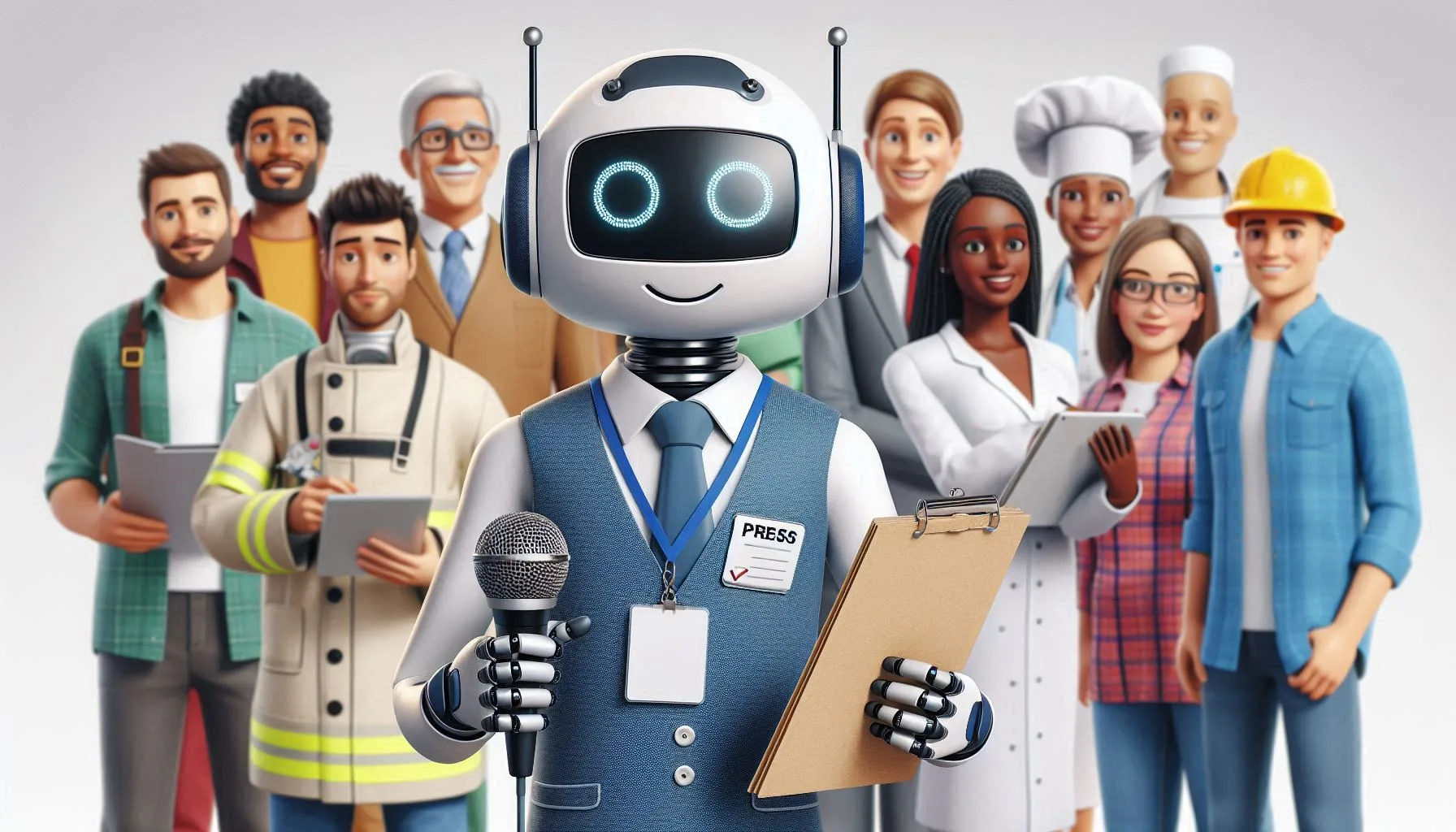The rise of artificial intelligence (AI) in journalism is reshaping how news is gathered, produced, and delivered. As technology evolves, so does its impact on journalism, bringing new opportunities and challenges. AI is now at the core of several journalistic processes, enhancing reporting accuracy, speed, and efficiency. In the future, its role will likely expand, making journalism even more data-driven, personalized, and timely. But what does it mean for AI to act as a “journalist”? And how can AI continue to support human journalists in the years to come?
The Current Role of AI in Journalism
Today, AI is already embedded in many areas of journalism, assisting in tasks that range from data processing to content creation. Here are some of the primary ways AI is contributing:
1. Automated News Writing
AI can now write short news articles on topics like sports scores, stock updates, or weather forecasts. News organizations use AI-driven tools such as Wordsmith, Heliograf, and Narrative Science to produce short, fact-based reports that would otherwise require significant human time and resources. These AI-powered systems turn data into readable narratives, enabling news outlets to cover more stories without stretching their human staff too thin.
2. Data Analysis and Insight Generation
Journalists often work with large datasets, particularly in investigative journalism. AI can assist by processing these datasets quickly and identifying patterns that may go unnoticed by human eyes. For instance, AI-driven data analysis can reveal trends in government spending, climate data, or crime statistics, supporting journalists in crafting evidence-backed stories. Programs like OpenAI’s GPT-4, combined with powerful data tools, help journalists make sense of complex data and extract meaningful insights faster.
3. Content Personalization
Many news websites now use AI algorithms to personalize content for individual readers. By analyzing users’ reading habits, AI helps tailor the news experience, showing articles based on the user’s past reading behavior, location, and preferences. This personalization increases engagement, as readers are more likely to stay on a website when they find content directly relevant to them.
4. Fact-Checking and Verification
AI also aids journalists by verifying facts quickly and accurately. Fact-checking tools, such as ClaimBuster and Full Fact, use natural language processing (NLP) to scan articles, social media posts, or speeches and compare them to reliable sources. This enables journalists to spot inaccuracies or confirm information before publishing, which is essential in today’s fast-paced, information-driven environment.
5. Moderating and Filtering Content
AI-driven tools help newsrooms manage online comments and detect harmful or offensive language. For example, the Jigsaw Perspective API, developed by Google, allows media companies to filter comments in real-time, protecting online spaces from abuse and keeping discussions civil. AI-powered moderation saves time, ensuring that human moderators can focus on more nuanced interactions.
AI as a Journalist: What Would It Entail?
When we imagine AI acting as a “journalist,” we’re envisioning a system capable of performing all tasks that a human journalist would typically undertake, including research, interviews, analysis, and storytelling. Although AI might never replace human journalists entirely, it could, in the future, take on the role of an assistant journalist, filling gaps where speed, precision, and objectivity are essential.
1. Research and Data Mining
Future journalist AIs could autonomously search for information, scan thousands of databases, and pull information from multiple sources in real time. For instance, an AI journalist working on a political story might access public records, analyze policy documents, and cross-check facts instantly. With advancements in machine learning, AI could even predict public sentiment or identify trends across various media sources, enhancing its reporting depth.
2. Conducting Interviews with Realism
While it’s unlikely AI would replace the nuanced and human touch required in interviews, it might someday assist. Future AI programs could simulate conversations, providing responses based on a deep understanding of human language and tone. This AI might even conduct interviews with experts, asking probing questions based on pre-determined objectives. Although these AI-driven interviews might lack human empathy, they could still serve in fast-paced scenarios where brief, straightforward information is needed.
3. Writing and Editing with a Human-like Tone
Advances in NLP continue to make AI-written content more natural and human-like. A journalist AI might produce articles that reflect human style, incorporating subtle details and narrative techniques. For instance, rather than simply listing facts, future AI journalists could apply storytelling techniques, adjusting tone to match the mood of the topic or the publication’s brand voice. Human editors would still play an essential role, adding emotional depth and ensuring that the AI-written content aligns with editorial standards.
4. Creating Multimedia Content
With video and audio becoming more important in journalism, future AI systems might handle these forms of content creation as well. AI programs could generate news videos by assembling relevant images, clips, and animations, while voice synthesis technology could allow AI to narrate stories in a natural-sounding voice. Combining visual and audio elements autonomously could save media companies time and resources, especially in breaking news situations where rapid content delivery is crucial.
5. Maintaining Ethical Standards
One significant challenge for AI in journalism is ethics. To be trusted, an AI journalist would need to uphold strict ethical guidelines, ensuring objectivity and accuracy. The news industry already faces challenges regarding misinformation and bias, and AI could inadvertently exacerbate these issues. As AI continues to develop, safeguards and transparency measures must be in place to ensure that AI-driven journalism adheres to these high ethical standards.
How AI Supports Journalists Today
AI’s contribution to journalism extends beyond what it can accomplish autonomously. In most cases, it functions as an invaluable assistant, freeing human journalists from repetitive tasks and allowing them to focus on in-depth, creative work. Here are some specific ways AI supports journalists today:
1. Speeding Up Data-Driven Investigations
AI tools can quickly process and analyze enormous datasets, enabling journalists to explore data-centric stories more effectively. Investigative journalists at The Associated Press, for example, used AI to sift through documents for stories on public health and corruption. By automating data processing, AI reduces the time it takes to discover key insights, allowing journalists to focus on storytelling and analysis.
2. Enhancing Real-Time Reporting
In fast-paced situations, such as election coverage or natural disasters, AI can analyze live data feeds and generate summaries. These real-time updates provide audiences with the latest information and free human journalists to focus on in-depth analysis rather than short updates.
3. Improving Content Discovery and SEO
AI helps news organizations understand what readers are searching for, enabling them to optimize content for search engines. By analyzing user data, AI identifies popular topics, keywords, and trends, which journalists can incorporate into their writing. AI-powered SEO tools, like SEMrush or Ahrefs, also assist journalists in crafting headlines and selecting keywords that improve article visibility.
4. Reducing Bias and Ensuring Fairness
AI-based tools, such as the Bias Meter, analyze articles to detect bias in language or coverage. Although AI itself can reflect biases present in training data, carefully designed systems help journalists maintain neutrality by flagging biased language. This feature is valuable for newsrooms aiming to uphold high ethical standards and deliver balanced content.
5. Augmenting Visual and Audio Content Creation
AI also supports journalists by generating visual content, such as infographics, and audio content, like podcast segments. AI-driven tools can transform data into visual representations, making complex stories more accessible to readers. AI-powered voice synthesis also allows journalists to create audio versions of their articles, broadening their audience reach.
The Future of AI in Journalism: Opportunities and Challenges
Looking ahead, AI’s role in journalism will likely grow, but it will come with significant ethical and practical challenges. Some future implications include:
1. Increased Audience Personalization
As AI improves, it will better understand individual preferences, presenting users with hyper-personalized news feeds. This approach could increase reader engagement and ensure people receive content that resonates with them. However, it also raises concerns about echo chambers, where readers only see content aligning with their existing views. To counter this, AI systems must prioritize balanced news exposure.
2. AI-Enhanced Investigative Journalism
Future AI tools might access diverse sources, from social media posts to satellite imagery, to uncover stories in ways that were previously impossible. AI’s pattern recognition capabilities could even help predict events, assisting journalists in warning the public before crises unfold.
3. Ethics and Accountability in Automated Journalism
As AI’s role grows, so does the need for ethical oversight. Journalists and developers must work together to establish accountability measures for AI-driven content. Transparency about AI’s role in news production will be essential to maintain public trust.
4. Collaboration Between AI and Journalists
In the future, AI and human journalists will likely work in closer synergy. Rather than replacing journalists, AI could serve as an advanced assistant, performing tedious tasks and leaving journalists free to focus on creative, high-stakes work. This collaboration will empower journalists to produce high-quality, impactful stories that AI alone could not create.
Conclusion
AI is transforming journalism, enhancing productivity, personalization, and accuracy. While AI may never fully replace human journalists, it is well on its way to becoming an indispensable tool in the field. As AI continues to evolve, its role in journalism will likely grow, allowing it to take on more responsibilities while requiring strict ethical guidelines and human oversight.
In the future, AI and human journalists will work side by side, with AI handling routine tasks and data analysis, and human journalists focusing on creativity, investigative work, and ethical judgment. This partnership will push journalism into a new era, where information is not only faster and more personalized but also more accessible and reliable for audiences worldwide.




